
HMS Scorpion was an ironclad turret ship built by John Laird Sons & Company, at Birkenhead, England. She was one of two sister ships secretly ordered from the Laird shipyard in 1862 by the Confederate States of America.
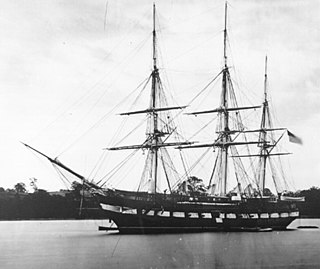
In the 18th century and most of the 19th, a sloop-of-war in the Royal Navy was a warship with a single gun deck that carried up to eighteen guns. The rating system covered all vessels with 20 guns and above; thus, the term sloop-of-war encompassed all the unrated combat vessels, including the very small gun-brigs and cutters. In technical terms, even the more specialised bomb vessels and fireships were classed as sloops-of-war, and in practice these were employed in the sloop role when not carrying out their specialised functions.

Woolwich Dockyard was an English naval dockyard along the river Thames at Woolwich in north-west Kent, where many ships were built from the early 16th century until the late 19th century. William Camden called it 'the Mother Dock of all England'. By virtue of the size and quantity of vessels built there, Woolwich Dockyard is described as having been 'among the most important shipyards of seventeenth-century Europe'. During the Age of Sail, the yard continued to be used for shipbuilding and repair work more or less consistently; in the 1830s a specialist factory within the dockyard oversaw the introduction of steam power for ships of the Royal Navy. At its largest extent it filled a 56-acre site north of Woolwich Church Street, between Warspite Road and New Ferry Approach; 19th-century naval vessels were fast outgrowing the yard, however, and it eventually closed in 1869. The former dockyard area is now partly residential, partly industrial, with remnants of its historic past having been restored.
Six ships of the Royal Navy have been named HMS Amethyst, whilst another was planned:

The Atlantic Telegraph Company was a company formed on 6 November 1856 to undertake and exploit a commercial telegraph cable across the Atlantic ocean, the first such telecommunications link.
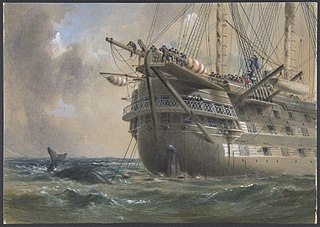
HMS Agamemnon was a Royal Navy 91-gun battleship ordered by the Admiralty in 1849, in response to the perceived threat from France by their possession of ships of the Napoléon class.

The Kingston Royal Naval Dockyard was a Royal Navy Dockyard from 1788 to 1853 in Kingston, Ontario, Canada, at the site of the current Royal Military College of Canada.

HMS Vixen was an armoured composite gunboat, the only ship of her class, and the third ship of the Royal Navy to bear the name. She was the first Royal Navy vessel to have twin propellers.

SS Royal Iris was a Mersey Ferryboat built in 1906 for Wallasey Corporation. She was built as Iris for service on the River Mersey. In 1918 she was requisitioned by the Royal Navy for action during the Zeebrugge Raid. She was renamed Royal Iris in recognition of her part in this action and returned to civilian duties. She was sold in 1931 and renamed Blarney in 1946. She was scrapped in December 1961.
The Maritime history of the United Kingdom involves events including shipping, ports, navigation, and seamen, as well as marine sciences, exploration, trade, and maritime themes in the arts from the creation of the kingdom of Great Britain as a united, sovereign state, on 1 May 1707 in accordance with the Treaty of Union, signed on 22 July 1706. Until the advent of air transport and the creation of the Channel Tunnel, marine transport was the only way of reaching the British Isles. For this reason, maritime trade and naval power have always had great importance.

HMS Bonaventure was a submarine depot ship of the Royal Navy. She was initially built for civilian service with the Clan Line, but on the outbreak of the Second World War she was requisitioned by the Navy and after being launched, was converted for military service.
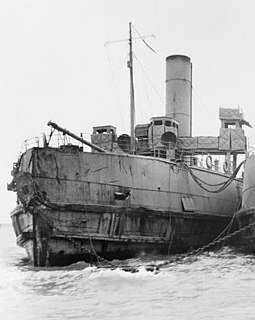
SS Royal Daffodil was a Mersey ferry, built in 1906 and scrapped in 1938. She was built as Daffodil but renamed Royal Daffodil in recognition of her service under requisition during the 1st World War.
HMS Viper was an armoured iron gunboat, the only ship of her class, and the fourteenth ship of the Royal Navy to bear the name.
HMS Niemen was a Royal Navy 38-gun fifth-rate frigate. She began her career as the Niémen, a 44-gun French Navy Armide-class frigate, designed by Pierre Rolland. She was only in French service for a few months when in 1809 she encountered some British frigates. The British captured her and she continued in British service as Niemen. In British service she cruised in the Atlantic and North American waters, taking numerous small American prizes, some privateers but mostly merchantmen. She was broken up in 1815, at the end of the Napoleonic Wars and the War of 1812.

HMS Amethyst was a Royal Navy 36-gun Penelope-class fifth-rate frigate, launched in 1799 at Deptford. Amethyst served in the French Revolutionary Wars and the Napoleonic Wars, capturing several prizes. She also participated in two boat actions and two ship actions that won her crew clasps to the Naval General Service Medal. She was broken up in 1811 after suffering severe damage in a storm.

HMS Mullett was a Royal Navy 5-gun Philomel-class wooden screw gunvessel launched in 1860. She served on the coast of West Africa and on the North America and West Indies Station before being sold in 1872 at Hong Kong for mercantile use. As the sailing ship Formosa she sailed in the Far East before being converted to a magazine in Melbourne.

HMS Iris was a 26-gun sixth-rate frigate launched on 14 July 1840 from Devonport Dockyard. She spent some time with the West Africa Squadron suppressing the slave trade and later with the East Indies Station was involved in operations in Borneo. Iris was the first flagship of the Australia Station between 1859 and 1861 during which time she participated in the First Taranaki War. In 1864 she was extensively modified to allow her to ferry transatlantic telegraph cable to the cable-laying ship Great Eastern. She was decommissioned and sold off in 1869.
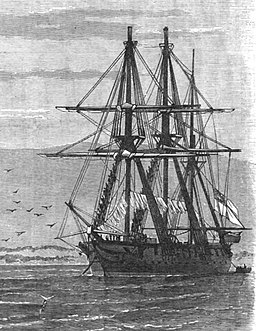
HMS Niger was an 8-gun screw sloop launched on 18 November 1846 from Woolwich Dockyard. She had been intended as a sailing sloop but her design was lengthened to fit a steam engine, and she was fitted with screw propulsion at Deptford Dockyard in 1847-48 prior to completion. She was reclassified as a corvette in 1852.
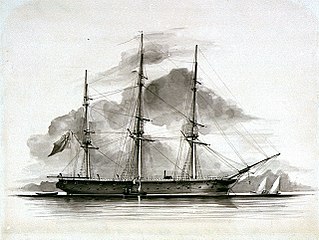
HMS Brisk was a 14-gun wooden-hulled screw sloop of the Royal Navy, launched on 2 June 1851 from Woolwich Dockyard. She served in the Crimean War and as part of the West African anti-piracy patrol, as well as during the New Zealand Wars. She was sold in 1870.
The Highflyer-class corvettes were a pair of 21-gun wooden screw corvettes built in the 1850s for the Royal Navy.
















